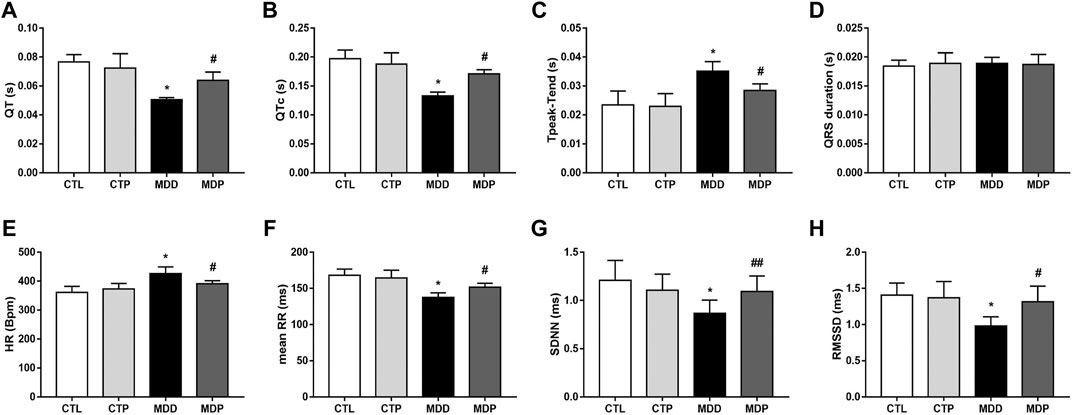- 1Department of Cardiology, Renmin Hospital of Wuhan University, Wuhan, China
- 2Cardiovascular Research Institute, Wuhan University, Wuhan, China
- 3Hubei Key Laboratory of Cardiology, Wuhan, China
A corrigendum on
Pinocembrin Decreases Ventricular Fibrillation Susceptibility in a Rat Model of Depression
by Ye, T, Zhang, C, Wu, G, Wan, W, Guo, Y, Fo, Y, Chen, X, Liu, X, Ran, Q, Liang, J, Shi, S, and Yang, B (2020) Front. Pharmacol. 11:547966. doi: 10.3389/fphar.2020.547966
In the original article, there was a mistake in Figure 6 as published. The unit of ordinate "s" was incorrectly written as "ms" in Figures 6A-D. The corrected Figure 6 appears below.

FIGURE 6. Electrocardiogram parameters and HRV. (A–D) QT interval, corrected QT interval, Tpeak–Tend interval and QRS interval, respectively. n = 7 per group. (E–H) Statistical analysis of HR, mean RR, SDNN, and RMSSD, respectively. n 7 per group. *p < 0.01 vs. CTL; #p < 0.01 vs. MDD; ##p < 0.05 vs. MDD. HRV, heart rate variability.
In the original article, there was an error. We missed the word “increases” in the section of Limitations. A correction has been made to Limitations, Sentence 13:
“In the present study, pinocembrin attenuates ventricular electrical remodeling, autonomic remodeling, and ion-channel remodeling (Cav1.2 and Kv4.2), lowers ventricular fibrosis, increases the expression of Cx43, and suppresses the inflammatory responses, which helps to decrease VAs in rats at the level of the heart.”
The authors apologize for this error and state that this does not change the scientific conclusions of the article in any way. The original article has been updated.
Keywords: depression, ventricular fibrillation, ventricular fibrosis, pinocembrin, autonomic remodeling, ventricular electrical remodeling
Citation: Ye T, Zhang C, Wu G, Wan W, Guo Y, Fo Y, Chen X, Liu X, Ran Q, Liang J, Shi S and Yang B (2021) Corrigendum: Pinocembrin Decreases Ventricular Fibrillation Susceptibility in a Rat Model of Depression. Front. Pharmacol. 12:647320. doi: 10.3389/fphar.2021.647320
Received: 29 December 2020; Accepted: 15 April 2021;
Published: 04 May 2021.
Edited by:
Francesco Rossi, University of Campania Luigi Vanvitelli, ItalyReviewed by:
Cees Korstanje, Scenic Biotech B.V., NetherlandsCopyright © 2021 Ye, Zhang, Wu, Wan, Guo, Fo, Chen, Liu, Ran, Liang, Shi and Yang. This is an open-access article distributed under the terms of the Creative Commons Attribution License (CC BY). The use, distribution or reproduction in other forums is permitted, provided the original author(s) and the copyright owner(s) are credited and that the original publication in this journal is cited, in accordance with accepted academic practice. No use, distribution or reproduction is permitted which does not comply with these terms.
*Correspondence: Bo Yang, eXliYjExMkB3aHUuZWR1LmNu; Shaobo Shi, NzE3NTcxOTgyQHFxLmNvbQ==
†These authors have contributed equally to this work
 Tianxin Ye
Tianxin Ye Cui Zhang1,2,3†
Cui Zhang1,2,3† Bo Yang
Bo Yang